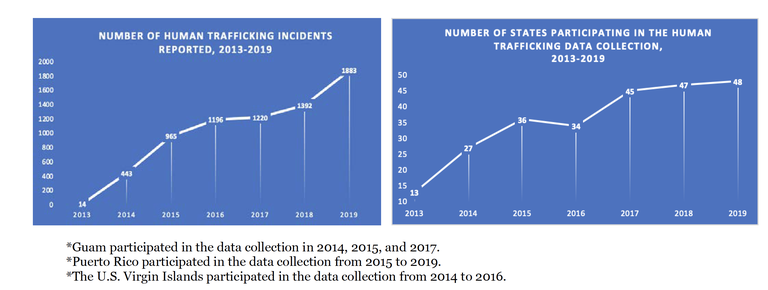Human Trafficking
Human Trafficking, 2019, is the seventh report from the national Uniform Crime Reporting (UCR) Program’s Human Trafficking data collection. Forty-eight (48) states and the U.S. territory of Puerto Rico participated. The 2019 report shows a total of 1,883 incidents of human trafficking were reported: 1,607 were in the category of commercial sex acts, and 274 were instances of involuntary servitude. (Puerto Rico submitted two incidents in the Total column and did not specify whether those incidents were under the category of commercial sex acts or involuntary servitude.) Agencies arrested 708 offenders in correlation with these incidents. Of these, 684 were adults and 24 were juveniles.
Participation
Since its inception in 2013, the FBI’s Human Trafficking data collection has, for the most part, seen a steady increase in state participation as well as an increase in the number of incidents reported. The program will continue efforts to expand, gather, and make available information regarding human trafficking incidents.

Trafficking Victims Protection Act
In January 2013, the national UCR Program began collecting offense and arrest data regarding human trafficking as authorized by the William Wilberforce Trafficking Victims Protection Reauthorization Act of 2008. The act requires the FBI to collect human trafficking offense data and to make distinctions between prostitution, assisting or promoting prostitution, and purchasing prostitution.
To comply with the Wilberforce Act, the national UCR Program created two additional offenses in the Summary Reporting System (SRS) and the National Incident-Based Reporting System (NIBRS) through which the UCR Program collects both offense and arrest data. The definitions for these offenses are:
Human Trafficking/Commercial Sex Acts: inducing a person by force, fraud, or coercion to participate in commercial sex acts, or in which the person induced to perform such act(s) has not attained 18 years of age.
Human Trafficking/Involuntary Servitude: obtaining of a person(s) through recruitment, harboring, transportation, or provision, and subjecting such persons by force, fraud, or coercion into involuntary servitude, peonage, debt bondage, or slavery (not to include commercial sex acts).
The data in the tables included in this report reflect the offenses and arrests recorded by state and local law enforcement agencies (LEAs) that currently have the ability to report the data to the national UCR Program. As such, they should not be interpreted as a definitive statement of the level or characteristics of human trafficking as a whole. The data declaration pages, which will help the user better understand the data, and the methodology used for the four following tables are located in the Data Declarations and Methodology section of this report. In addition, a Question and Answer section about human trafficking data is provided as a supplement to this report.
Note: Regarding the data reported to the UCR Program, it is important to note that these data represent only one view of a complex issue—the law enforcement perspective. However, due to the nature of human trafficking, many of these crimes are never reported to the local, state, tribal, and federal LEAs that investigate them. In addition to the law enforcement facet in fighting these crimes, there are victim service organizations whose mission it is to serve the needs of the victims of human trafficking. In order to have the complete picture of human trafficking, it would be necessary to gather information from all of these sources.

